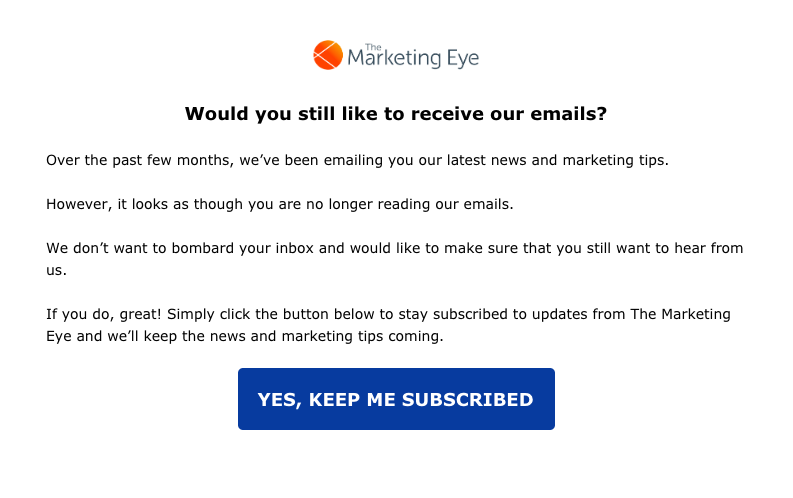What you need to do when the relationship is on the rocks
Your marketing contacts aren't engaging with your emails anymore - what do you do now?Email marketing is the best form of marketing. You are communicating directly with a group of contacts that already know who you are. You share something, a common bond, a connection, that in business terms is worth something to both of you. You offer a product and service that they are willing to give you access to their inbox for: it feels nice.
Unfortunately, not all love lasts, and sometimes, no matter how many flowers and chocolates you send, they just aren’t interested in hearing about what you have to offer anymore.
Like any relationship when the love is lost, you can try and work things out, but if it doesn’t, you must eventually let go. And it’s the same with email marketing.
Case Study: Peer to Peer Business Lender
How we developed a unique targeting approach and improved lead volumes from direct marketing by more than 80%.
I have documented why holding onto a contact that doesn’t engage with your emails anymore isn’t good for your business. It was born out of having the same conversation with different people over and over again, but the good news is there’s a healthy way to end a relationship for both parties.
These are the four steps to take when someone isn’t opening your emails anymore
Leave them alone for a bit
When things don’t quite feel as they were, it can be a good idea to give each other some space. Absence can make the heart grow fonder.
You can look at it in a similar way with email marketing. If you have sent someone a dozen emails without them opening any of them – what makes you think they are going to open a thirteenth? The reality is, that no matter how good your email is, the thirteenth email probably isn’t even going to go into their inbox, let alone will they open it.

Case Study: PrimeStox
How we helped PrimeStox treble registrations while reducing spend in just two months.
Why?
ISP’s, such as Gmail and Outlook, use engagement as a metric for deciding where to place your emails. How does Google know where to put emails in your promotions tab? The answer is engagement.
Case Study: Peer to Peer Business Lender
How we developed a unique targeting approach and improved lead volumes from direct marketing by more than 80%.
If you hold off from sending to these contacts for a few months and just continue to send to your engaged contacts (i.e. the contacts that open and click your emails on a regular basis), it will improve your sender reputation. This will lead to the ISPs thinking your emails are "can’t miss” and will improve your chances of getting back into a previously unengaged contacts inbox.
Although you will never get a 100% open rate, you should view email marketing in the same way as the emails you send to your colleagues and friends. When you send an email to a colleague, you pretty much know it is going to be read and that’s what you should expect from your email marketing efforts, otherwise… why are you sending them?
Clean your database
Sometimes people change. Perhaps the individual you fell in love with isn’t the same person anymore, or they’ve moved on to different things.

Case Study: PrimeStox
How we helped PrimeStox treble registrations while reducing spend in just two months.
The same can be said of an email address. The easiest example is that they no longer work at the company where the email address is directed to.
No big deal you might think.

Case Study: The Replace Base
An online retailer of mobile device repairs and replacement parts
Wrong.
These contacts are hurting your sending reputation, your IP address and your domain.
Known as recycled spam traps; email addresses that have been abandoned for anywhere between one to four years can be picked up by spam trap operators and can lead to your emails being blacklisted and not getting delivered… and that includes to your engaged contacts!
Putting your unengaged data through an email verification tool, such as BriteVerify, Zero Bounce or Hunter, will help weed out these email addresses. Also, don’t ever ignore out of office replies. If they say the contact has left the company, then delete or unsubscribe the contact from your database.
Re-engagement campaign
Your relationship is on the rocks. You’re not speaking much anymore, and you feel like the other person has moved on. But, you’ve given them some space and you’ve checked to see if they are ok. Now it’s time to put some hard graft in and see if you can win them back.
A re-engagement campaign is specific and made solely for the purpose of winning back dormant contacts. Here, the use of personalisation is key.
What you’re trying to do is to get the recipient to take action, be that in the form of an email open, a click or a purchase. You are essentially looking for a sign of a pulse, an indication that there is still hope.
Your best chance of getting that is by offering something so irresistible that they can’t help but fall in love with you again. That is why personalisation is important here. If you’ve been collecting data about recipients over a course of time, you should be able to offer something that you know they are going to like.
Re-confirmation email
Do you still love me?
Here it is, your last chance to save your relationship.
A re-confirmation email is just that, asking them to re-confirm if they still want to receive emails from you. Not only is this a smart thing to do from a list management point of view, but it will also help you when it comes to GDPR, as it says you shouldn’t hold onto contact details for longer than necessary.
A simple link in your email, like the one below, is perfect. It is clear and the respondent is only going to click it if they still want your emails.

If they don’t respond, it’s time to end the relationship by unsubscribing them from your database. It may not feel like the best thing to do, but it is the right thing to do - for the health of your remaining email contacts and future email delivery.
The relationship may be over, but there are plenty more fish in the sea, and you have dealt with this one in the right way. You are now ready to reel in some more catch and win over more customers!
If you want to know more about the importance of maintaining a healthy email database, get in contact with us, and we will be happy to talk to you about developing a winning email strategy.
Related Reading

Blog: How to Stop Your Email Newsletters from Going to Spam
by Darren Coleshill, 5 minute read

Blog: Why Custom URLs Are Essential for Your Business
by Darren Coleshill, 3 minute read